San Diego’s transboundary sewage challenge
San Diego’s environmental crisis is caused by unprecedented, uncontrolled flows of sewage and debris from south of the border. Tijuana’s population has doubled since the plant was built in 1997, far outstripping its capacity to collect and treat wastewater, with much of its infrastructure broken and some areas lacking any sewers at all. More than 2.2 million people live in greater Tijuana, and much of the city’s human, industrial and commercial sewage simply flows untreated into the Pacific Ocean or the Tijuana River, fouling San Diego County’s air and water with odors and pollution.
A small portion of Tijuana’s sewage runoff is directed to the South Bay International Wastewater Treatment Plant (South Bay), which the U.S. government built to prevent the most direct flows of wastewater into the Tijuana River. The South Bay plant is owned by the U.S. International Boundary and Water Commission (IBWC), a federal agency that manages issues along the border with Mexico. As Tijuana’s population grew and its supporting infrastructure failed, however, the South Bay plant began to receive flows well in excess of what it was designed and built to treat.
Veolia has operated the South Bay plant since it opened and its employees have worked tirelessly to keep it functioning, even as they had to treat more sewage with fewer resources. The U.S. government has funded a $600 million plan to rebuild the plant and double its capacity, thanks to the strong efforts of the IBWC and California’s congressional delegation to obtain the funding necessary to help the residents of San Diego. However, even a rebuilt and expanded South Bay plant will not resolve this complex problem, as the expansion is likely to treat only a portion of Tijuana’s wastewater.
Much of Tijuana’s sewage still flows directly through its beaches to the Pacific Ocean where it washes north to San Diego, or through the Tijuana River into San Diego’s South Bay. This is the source of the odors and pollution that torment San Diego, and the crisis will not abate until Mexico properly collects and treats the wastewater generated by one of its fastest-growing cities. Veolia is committed to partnering with local, state and federal officials throughout the region to advocate for a permanent bi-national solution.
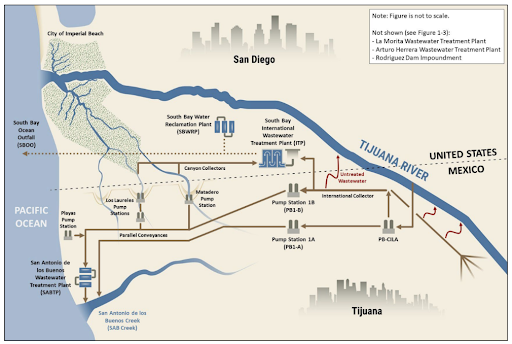
Map showing sewage infrastructure and flows in the Tijuana River Valley
Veolia’s operation at the South Bay International Wastewater Treatment Plant
Veolia North America has helped operate the South Bay plant under the direction of the IBWC since it opened in 1997. At that time, the plant was capable of treating up to 25 million gallons of sewage from Tijuana per day. Nearly three decades later, Tijuana’s population has doubled and flows of raw sewage from across the border have more than tripled.
The South Bay plant faces unprecedented flows of sewage, debris and silt from Tijuana that have destroyed equipment, overwhelmed treatment systems and filled treatment tanks with mud and silt. Issues at the plant have also been exacerbated by extreme weather events and massive amounts of sediment coming from a large highway construction project in Matadero Canyon on the Mexican side of the border. Veolia’s local employees work at the front line of this crisis, doing their best to operate a facility well beyond its design capacity.
From 2010 to 2020 Veolia recommended extensive investments in capital repairs and upgrades to help the South Bay plant, but due to limited budgets, the IBWC spent only $4 million on major repairs and capital requirements.
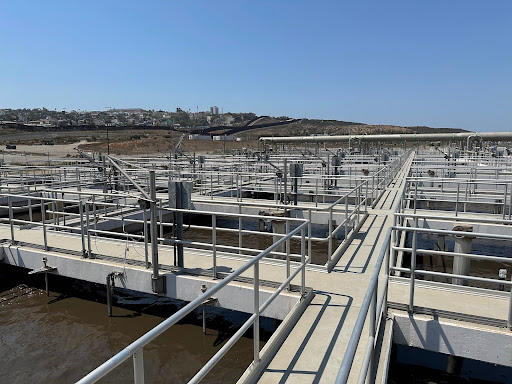
Wastewater treatment tanks at the South Bay plant just north of the Mexican border
Congress has since allocated the IBWC more than $600 million in new funding, thanks in part to strong advocacy by local, state and federal government officials in the affected area, and has embarked on a major expansion and reconstruction project that will double the plant’s treatment capacity.
However, rebuilding and expanding the South Bay plant will not fully solve the sewage crisis afflicting the region. Most of Tijuana’s sewage never enters the plant and can only be controlled by Mexico. In fact, the South Bay plant does not discharge to the Tijuana River, and the wastewater it treats is released through a pipeline that discharges it miles offshore in the Pacific Ocean.
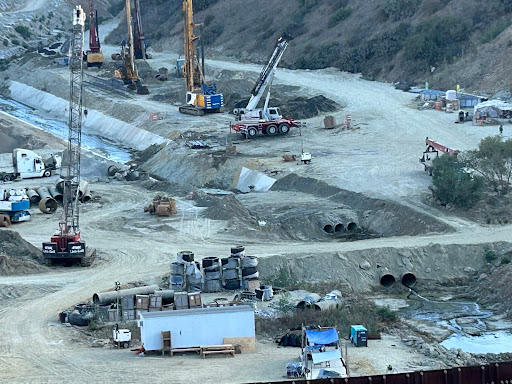
A major highway construction project just across the border in Mexico has filled the drainage channels with dirt and debris that washes into IBWC plant infrastructure, ruining equipment and clogging treatment systems.
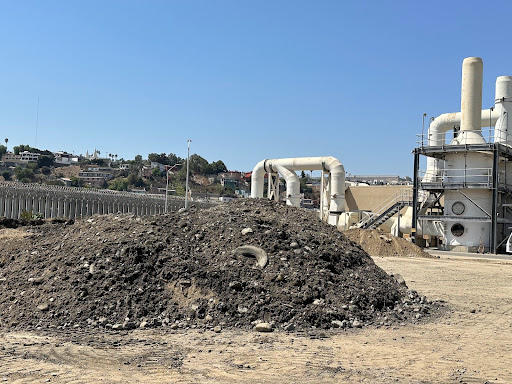
Debris removed from incoming wastewater at the South Bay plant includes tires, rocks and unidentifiable garbage that can clog and destroy equipment.
Veolia’s efforts toward a long-term solution
Throughout the San Diego region, elected officials and advocacy groups understand that a permanent fix to the problem will require coordinated action by the U.S. and Mexican governments to repair infrastructure, build additional capacity and better control flows. Despite this clear consensus, some parties have tried to place blame on Veolia and have filed legal claims against the company.
Veolia will aggressively defend our company and our employees against unfounded attacks that have no basis. No amount of dishonest rhetoric from opportunistic lawyers can change the reality that Veolia has done an excellent job helping to operate the South Bay plant within the constraints imposed by a critical lack of government funding and resources on both sides of the border.
With proper support from partners on both sides of the international border, progress can be possible. Veolia constantly strives to improve plant operations despite pollution, mismanagement, and extreme conditions at the border that are outside of its control.
Veolia has joined San Diego’s Congressional delegation and local elected officials in their successful advocacy for additional support from Congress to fully fund the expansion of the South Bay treatment plant.
With its own employees literally at the front lines of confronting Tijuana’s increased flood of sewage and other debris, Veolia shares the region’s urgency in addressing the situation, and looks forward to working with our government partners to help bring about a long-term solution.
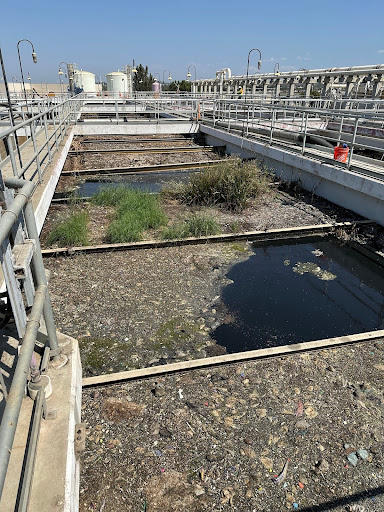
Sedimentation tank filled with silt and debris that overwhelmed the South Bay plant

